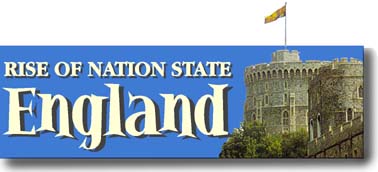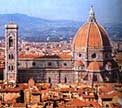|
|


Mr. Sedivy's
History Classes:









More Features:


 

 

|
|
Highlands Ranch High School - Mr. Sedivy
Highlands Ranch, Colorado
Rise of Nation State England
- Christianity Comes to Britain
-
Heathens Become Christians
The English invaders were "heathens." The English wore charms to keep
away evil spirits. They believed in dragons, giants, and more. Their
chief god was "Woden," and all Anglo-Saxon kings claimed to be
descended from him.

Woden, Germanic god of war. Woden is shown crowned
and surrounded by
six of his sons: Vectan (Kent), Bealdeah (Wessex), Feothulgeat (Mercia),
Beldei (Northumbria), Casere (East Anglia), and Wegdam (Sussex).
English Gods / Our Calendar
There were more gods. Tiw was a war god. Thunor, was the god of thunder,
the sound of which was believed. Frig was a goddess and was supposed
to bring good harvests. These gods are still remembered today in the
days of our week: Tuesday (Tiw), Wednesday (Woden), Thursday (Thunor),
and Friday (Frig). Saturday probably comes from Saturn, the Roman
god of agriculture. Sunday and Monday are named after the sun and
moon, both worshipped by Anglo-Saxons.
Pope Gregory / King Æthelberht of Kent
Pope Gregory the Great decided to send missionaries to convert the
English. Forty monks from Rome went to England in 597. The missionaries
were led by Augustine. The king of Kent, Ethelbert, had a Christian
wife named Bertha. He was still a heathen, but agreed to meet with
Augustine as long as they would meet in the open air where they could
not work their magic on him.
Ethelbert must have been surprised by the sight of shaven headed
monks, wearing black Benedictine robes and chanting in a strange language.
But, he decided to trust them. Ethelbert gave the monks food and shelter
at Canterbury and allowed them to preach at his people. With queen
Bertha's permission, the monks used an old Roman church, St. Martin.
The next year year, Ethelbert had been baptized and so had thousands
of his people. (The hierarchy of the Roman Church: Pope > Cardinal
> Archbishop > Bishop > Abbot > priest > monk.) Gregory made Augustine
Archbishop of Canterbury. Pope Gregory gave Augustine instructions
about how to set up the English Church.

Augustine did not destroy the heathen temples, but instead he decided
to change them into churches, replacing the idols with altars. "Christmas"
replaced the winter feast of "Yule." Easter is still named after a
Saxon spring goddess, Eostre. Gregory and Augustine both died in 604.
Soon afterward, there were again heathen ways. King Redwald decided
to give them the best of both worlds - Christ and one for the heathens'
gods!
Christianity in Ireland
Ireland became a stronghold of Christianity. Saint Patrick was a Briton
who became a monk in Gaul. In the fifth century, Patrick traveled
throughout Ireland preaching and baptizing the people. An Irish monk
named Columba sailed across to the land of the heathen. On the island
of Iona, he set up a monastery with twelve other monks. Iona remained
an important center of the British - Celtic church.
Christianity in England
As you can see, Christianity came from two different directions in
England - from the north, St. Patrick and Columba; and from the south,
Romana and St. Augustine. The North and Midlands were led by "Celtic
Christians" from Iona. They did not follow the Pope's leadership.
They had a different date for Easter and Christmas. Celtic monks even
had a different tonsure (haircut). It was a semicircular patch from
ear to ear.
King Oswy
Northumbrian King Oswy followed Celtic practices, but his wife, the
queen, had been taught Roman ways. He wanted to bring all English
Christians together. He convened a synod (council) at Whitby to agree
on the dating of Easter and Christmas. The bigger question was: Would
Celtic Christians be willing to accept Roman leadership? In the end,
the arguments of the Roman Christians convinced King Qswy. Now, only
English bishops were in touch with Rome and other parts of Europe.
The Celtic Church
The Celtic church was based on monasteries. The Roman Church was organized
differently. Countries were divided into large districts called "dioceses,"
each under a bishop with a cathedral. In later centuries, dioceses
were subdivided into parishes, each with a priest to serve the needs
of the people. Churches were expensive to build, so monks held outdoor
services. They built "waysidecrosses" made of wood. (Some were made
of carved stone.)
Boniface
The greatest of all Anglo-Saxon missionaries was Boniface, a monk
from Wessex. In 718, he left England never to return. He went to "heathen"
Germany and personally converted thousands of the people. In 754,
the "Apostle of Germany" was killed by nonbelievers.
Bede
Bede was a monk who wrote English history 300 years after the Romans
left. Bede, scholar of Northumbria, grew up in Northumbria. He wrote
"The History of the English Church and People," written in Latin.
His parents entrusted him to the care of monks at Wearmouth. Bede
left Wearmouth when he was still a boy, and spent the rest of his
life of Jarrow. He carefully studied old Anglo-Saxon stories, songs
and poems. Monks from all over the country sent documents to him.
Bede earned the nickname "Venerable" (worthy of respect). In 735,
the year of his death, York became the home of the second archbishop.
Back to top of page
Mr. Sedivy's Lecture Notes
& Historical Info
The Celts
| Gallic He-Men | Celtic
Culture, Trade, Religion, Women |
| Threat of the Celts - Celtic Battles and
Conquests |
- Rise of Nation State England -
| Roman Conquest of Britain | Christianity
in Britain |
| Customs: Thanes, Churls, Thralls, Wergeld,
Folk-Moot |
| Dark Ages: Alfred the Great, Edward the
Elder, Athelstan |
| The Return of the Vikings |
| Kings of Britain: Aethelred, Cnut, Edward
the Confessor |
| Bayeaux Tapestry, William the Conqueror,
Edward the Confessor, Harold Godwinson, Harold II |
| The Crusades: Richard Lion Heart, Pope
Urban |
| King John, Innocent III, Archbishop Stephen
Langton |
| Magna Carta / First Parliament |
Wales and Scotland
| Wales: Edward I, Llewellyn, Snowdonia
|
| Scotland: Alexander III, John Balliol,
William Wallace, Robert Bruce, King Edward II |
The 100 Years War
| Edward III, Longbows at Crecy, Edward IV,
Black Prince |
| Henry V, King Charles VI, Battle at Calais,
Treaty of Troyes |
More Information
| Other Kings of the Dark and Middle Ages:
William II, Henry I, Henry II |
| The
British Monarchy's Peerage: Dukes, Viscounts,
Marquess, Earls, Baronets, and Barons |
Class Activities
Roman Conquest Comparison
Battle of Agincourt
Related Information
Mr. Sedivy's World History - The Middle
Ages
The Complete Bayeux Tapestry
Roman Catholic Church in the Middle Ages
/ Crusades
The Hundred Years War
King Henry VIII
The Interesting
Life of Elizabeth I
The Stuarts - James I, Charles I, Charles
II, James II
Oliver Cromwell
|
|
|



![]() 9375 South Cresthill Lane
9375 South Cresthill Lane ![]() Highlands Ranch, Colorado 80126
Highlands Ranch, Colorado 80126 ![]() 303-471-7000
303-471-7000


